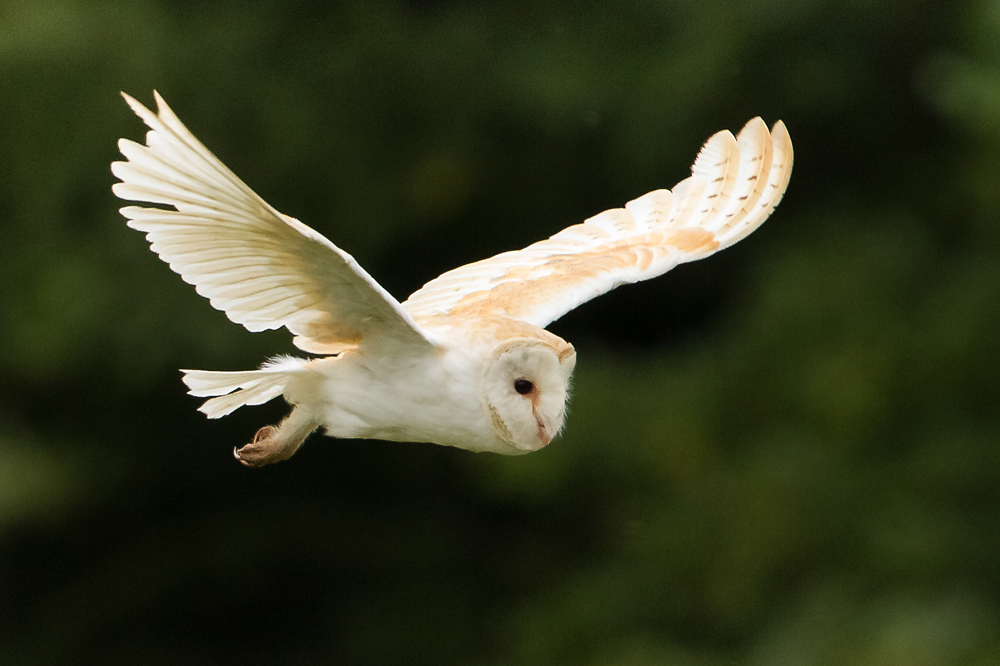Silent white: Barn owls are increasingly common across Cheshire’s oak-dotted pastures
Cheshire’s Sandstone Trail has long been popular with birdwatchers and nature lovers.
The Trail traces the line of wooded sandstone hills that run roughly north to south across the county and crosses a variety of other habitats from marshland to lowland heath, which means you’re likely to spot a good variety of Cheshire birds.
Birds to be seen along Cheshire’s Sandstone Trail range from the wildfowl and waders of the Mersey Marshes to kingfishers and water rails on the tiny River Gowy, as well as birds of prey such as short eared owls, barn owls, little owls, peregrines, sparrowhawks, kestrels and buzzards.
There are even goshawks in the broadleaf woodlands on the Peckforton Hills.
Birds on Frodsham Marshes
The old market town of Frodsham overlooks the broad Mersey Estuary, now cleaner than at any other time since the beginning of the Industrial Revolution.
Parts of the estuary have been recognised since the 1980s as being of international importance for feeding and roosting waders and wildfowl, including pintail, teal, widgeon, shelduck, redshank and dunlin.
The Frodsham Marshes and Frodsham Score, immediately to the north of the M56, provide outstanding birdwatching all year round. Regular visitors include hen and marsh harriers, short-eared owls, and a good variety of waders and other rarities. Spoonbills attempted to breed on the marshes in 1997 with up to six present during the summer. It’s a Cheshire birder’s heaven.
Once up on the Sandstone Trail, from Overton Hill to Delamere Forest, watch and listed for wrens, tits, finches, blackbirds, jays, woodpeckers, tawny owls and sparrowhawks among the trees.
In quieter areas, buzzards nest in the taller trees — and can be seen circling overhead or gorging on carrion in fields all along the Sandstone Trail.
Up on the Old Pale, look out for kestrel nesting boxes set on poles among the new plantations. Buzzards patrol the skies along the whole Trail, and passing ravens are common, too.
Delamere Forest Birds
Delamere Forest’s dense conifer plantations support fewer bird species than the mixed oak woods along the ridge, but you’re still likely to see or hear wrens, lesser- and greater spotted woodpeckers, and foraging parties of tits. Look out for jays, nuthatches and treecreepers. There are goshawks in the quieter parts of the forest, too.
Clear felled and ‘rewetted’ Blakemere Moss, in the heart of Delamere forest, is now a shallow, ink black lake that attracts breeding gulls, waders and other waterbirds. Look out for Canada geese, coots, moorhens, and sandpipers. Rare Mediterranean gulls have bred here in recent years.
Once the Sandstone Trail begins to cross Cheshire’s open, oak-dotted farmland, look out for little owls; they nest in the hedgerow oaks and are sometimes seen in daylight perched on a branch or fencepost, or in low undulating flight from tree to tree.
Between Tarporley and Beeston Castle, barn owl boxes on tall poles have been set up all along the River Gowy, and the nearby pasture oaks are home to little owls, too. There are breeding kingfishers and water rails along the Gowy, too.
Beeston and Bickerton Birds
Lofty Beeston Crag is home to nesting rock doves, jackdaws, ravens, kestrels and peregrines.
Look out for pied flycatchers in nestboxes in the woods alongside the Trail between Peckforton and Higher Burwardsley. There are occasional wood warblers among the mature oaks. Buzzards, ravens and sparrowhawks nest in the woods, too, as do occasional goshawks lured by the easy pickings of the estate’s pheasantries.
Where the steep western scarp slopes edge the sandstone ridge between Rawhead and Bickerton Hill, watch for swarms of swallows and house martins hawking for flies caught on the updrafts along the edge when warm summer breezes blow in from Wales.
Flycatchers and Redstarts
Pied flycatchers and redstarts nest on the hills, and tree pipits and merlins are occasionally seen. It’s also hoped that heathland birds such as nightjars and hobbies may return to the heath.
Southwest Cheshire’s open pastures still attract occasional coveys of grey partridges, while the low-lying, wetter ground along Bickley Brook provides valuable habitat for nesting lapwings.
The southernmost leg of the Trail, along the Llangollen Canal into Whitchurch, is characterised by tall, path side common reeds, mallard, herons, moorhens and other waterfowl.
Booking
Reserve your accommodation, transport and more here, now …

